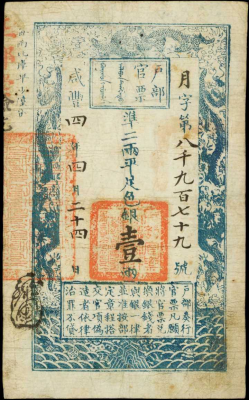During the Qing dynasty, the currency was bimetallic, with two kinds of money used: one for the wholesale market and another one for the retail market. Silver ingots were used for transactions that required big amounts of cash, such as in the wholesale market, while copper cash was used in the retail market for smaller exchanges.
Due to the history of paper money causing hyperinflation in the Jin, Yuan, and Ming dynasties, the Qing were cautious about using paper cash. In the beginning, the Manchus of the Qing dynasty attempted to put paper money in circulation. The minister of revenue, Wei Xiangshu, released the “Hubu Guanpiaom” and the “Shunzhi Guanpiao” or “Shunzhi Chaoguanduring” during the reign of the Shunzhi Emperor in 1651. These were the series of banknotes used for ten years while Shunzhi was taking over the Ming dynasty. According to the Chinese economic historian Peng Xinwei, this form of paper money stopped being printed because the Manchu leaders did not want to commit the same mistakes as the previous dynasties. This resulted in the use of sipao or promissory notes that Chinese merchants and banks used.
Paper money was only used again during the Xianfeng emperor’s rule due to large-scale rebellions and wars. During the Taiping Rebellion that started in 1850, the opposition obstructed the pathways that were supposedly used for minting metals from the southwest portion of China. This prompted Xianfeng’s counsel to produce money shaped after Xianfeng baochao called “Da-Qing Baochao.” This was modeled after the Da-Qing Baochao used during the Ming dynasty. The populace nicknamed the cash “qianpiao,” and it could be changed for copper cash coins.
Supposedly, the banknotes were to be circulated around the entire territory of the Qing. Specific bank groups such as the T’ien, Yu, and Ch’ien bank groups were tasked with printing and circulating the Da-Qing baochao banknotes in service to the Ministry of Revenue. However, the designated banks were operated by private merchants, and the government department failed to monitor the circulation of paper money. This resulted in the over-issue of these banknotes. Consequently, inflation rose during the time of Xianfeng. Paper money depreciated, and the people speedily retrieved their pawned possessions from T’ien stores. Consequently, the emperor had to close down these banks in 1861 because they became bankrupt.
Modern paper money was released again in the 1880s. Several banking businesses and credit companies opened in the aftermath of the new money system. These groups released paper money, and small businesses followed. These banks influenced the imperial court to print their own contemporary paper cash. In 1895, the imperial court issued the first yuan paper notes. These were printed in London with both Chinese and English transcriptions on them, considered the basis for modern Chinese paper bills.
In the 1990s, the Qing officials worked to decimalize the monetary system and established a national bank to take charge of printing official paper money. The Imperial Bank of China was completed in 1897. It was later renamed Commercial Bank of China in 1912.
In 1904, contemporary notes were printed by the Ministry of Treasury in Japan, releasing
1,5, and 10 yuan notes in a Western-inspired style vertical composition. Two years later, representatives traveled to Japan to be educated on the latest printing methods. Their objective was to print notes for the bank.
In 1907 all inscriptions on the banknotes were changed after the bank was renamed. The Xuantong administration was also in its beginning stages, issuing new paper money designs as a sign of the change in leadership.
